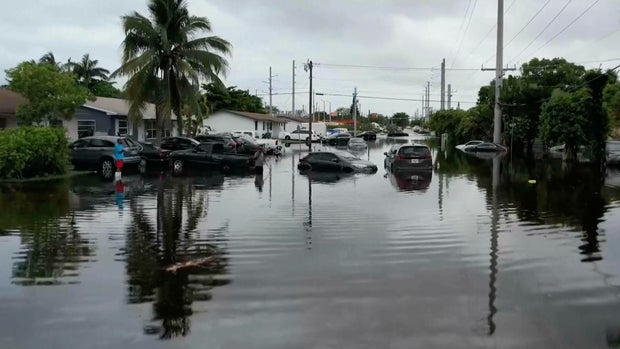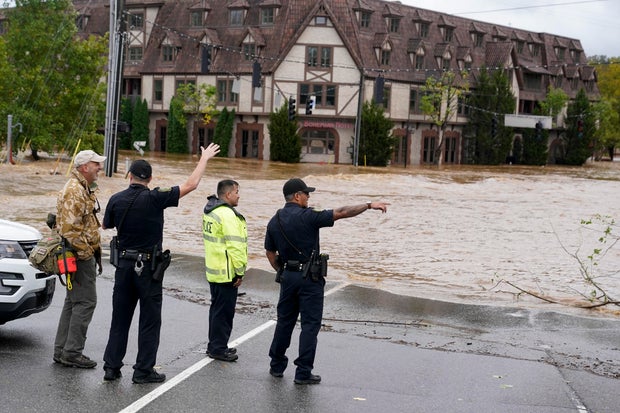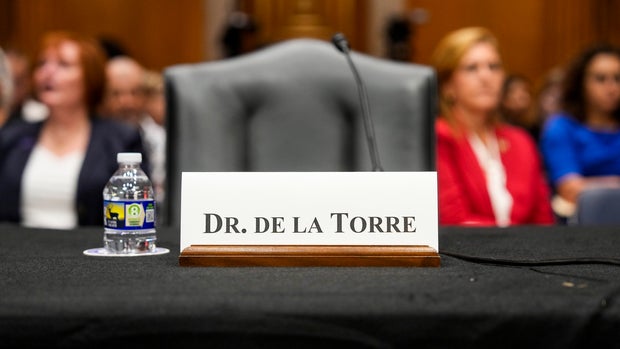CBS News
Maps and photos show massive rainfall in Florida as flooded communities face ongoing downpours

A relentless string of powerful storms soaked parts of southern Florida this week and today’s forecasts predict massive amounts of rain will pummel vast sections of the state through Friday.
As images emerged of children traversing South Florida streets in an inflatable raft, adults wading through knee-deep water covering neighborhood blocks, and cars stalled while submerged and stranded in the middle of roadways, meteorologists warned on Thursday that as much as 8 more inches of rain could accumulate in low-lying areas before the weekend. Officials said around 20 inches had fallen on Thursday afternoon in Hallandale Beach, near Fort Lauderdale. Videos from the southernmost Broward County city showed cars submerged to the hood.
Seven million people in South Florida were under flood watches or warnings on Thursday, with forecasters projecting the most severe weather for counties previously hit by earlier deluges in the last few days.
Marta Lavandier / AP
What communities in Florida will be impacted?
A tropical disturbance triggered a rare flash flood emergency warning across the tip of the Florida peninsula Thursday. Parts of South Florida, some of which were hit hardest by heavy rains and flooding earlier in the week, were bracing for another 4 to 8 inches of rainfall through Friday, said NEXT Weather meteorologist Lissette Gonzalez on CBS News Miami.
Meteorologists at the Weather Prediction Center had updated their risk profile for excessive rainfall in Florida’s southernmost areas to “high” early in the morning, explaining in a bulletin that the upgrade accounted “for significant impacts expected with the next round of heavy rainfall over extremely sensitive areas that include the urban corridor in Southeast FL through the I-75 corridor over Alligator Alley.”
Named after the reptiles that also inhabit the land, Alligator Alley runs horizontally across the Florida peninsula from around Fort Lauderdale on the West Coast to Naples on the East Coast. Florida wildlife officials have said that alligators and other wildlife could become more visible in flooded neighborhoods after a hurricane or tropical storm. It was not immediately clear whether current flooding would bring them out in the same way.
Daniel Kozin / AP
Gov. Ron DeSantis declared a state of emergency for multiple southern counties on Wednesday, while Miami-Dade Mayor Daniella Levine Cava, Miami Mayor Francis Suarez and Fort Lauderdale Mayor Dean Trantalis individually issued emergency declarations for their jurisdictions in response to torrential rain and flooding, which caused cars to stall and grounded flights at two major airports.
Those declarations trigger a set of emergency management protocols that allow authorities, either at the local or state level, or both, to access funds and other resources to respond to the weather. With the declaration in Miami, the city also set up distribution sites for sandbags, for residents to place outside the doors and windows of their homes to block out water, and opened nine public parking garages for people in flood-prone areas to leave their cars.
Another state of emergency was declared for the cities of Dania Beach and Sunny Isles Beach, as police and fire crews said they had conducted at least 40 rescues in Dania Beach in the midst of Wednesday’s storms, CBS News Miami reported. Photos and video out of Dania Beach showed streets completely flooded, with water levels in some instances as high as a car tire.
Many of those cities and counties braced for ongoing storms throughout Thursday, and a flood warning was active for Miami-Dade and Broward Counties until 4 a.m. ET on Friday morning.
Omar Zaghloul/Anadolu via Getty Images
How much rain is Florida forecast to get?
Storms have already dumped massive amounts of rain on much of southern Florida, with the latest precipitation reports suggesting as much as 20 inches fell in parts of Miami-Dade and Broward Counties. These totals were just shy of the record rainfall total recorded in the state over the last three days, which surpassed two feet of rain in the Everglades. Along the Gulf Coast, reports show at least 6 or 7 inches fell in several counties this week, and as much as 10 or 11 inches fell in several of them.
Wednesday’s rainfall set new records in a handful of places, including some as far north as Fort Myers and the Winter Haven Regional Airport, the latter of which is about halfway between Tampa Bay and Orlando, according to the weather service. In Fort Myers, the city’s latest rainfall of 3.86 inches surpassed its 2008 record-high of 2.14 inches. Precipitation records for Fort Myers date back more than a century.
New rainfall totals in and around Fort Myers could potentially surpass that record, as forecasters said 2 to 4 inches of rain had already fallen in the area early Thursday afternoon, and between 1 and 2 more inches was still expected.
Another heap of precipitation, potentially as much as 6 to 10 inches, could fall on parts of southwestern Florida throughout the rest of the week, they added, and the Weather Prediction Center noted that even higher amounts could potentially accumulate in isolated areas along the coast and extend inland to the interior part of the peninsula. The southwestern flood watch was set to expire at 8 p.m. ET on Thursday evening.
A flood watch was in place for communities along nearly a 100-mile stretch of Florida’s Gulf Coast, running from Tampa Bay through Fort Myers and extending inland for roughly the same distance at certain points in the watch area east of Sarasota. Meteorologists said that parts of coastal Sarasota County, which sits just below Tampa Bay, felt the brunt of the Gulf Coast weather on Wednesday, with 6 to 10 inches of rain recorded in various spots. One rainfall report showed almost 11.4 inches at a location in Sarasota.
Despite the significant rainfall that already hit western Florida and the additional totals expected, forecasters said widespread flooding probably would not materialize, since precipitation would be coming in spurts and the breaks in between allowing water to drain. The primary concern was localized flooding and, potentially, flooding in urban areas. “Heavy rainfall is forecast now through the weekend. At times, this could lead to mainly minor nuisance flooding in low-lying and poor drainage areas,” NWS Tampa Bay said Tuesday in a social media post.
The agency advised drivers in the area to avoid flooded roads — according to National Weather Service data, almost half of all flood-related deaths in the United States each year involve vehicles.
Although the Florida counties farthest south on the peninsula were expected to see the most damaging rainfall Thursday and Friday, meteorologists also warned that the proximity of certain places nearer the Gulf Coast could still face substantial threats of more heavy rain and flooding, especially in areas where the ground is already saturated from earlier storms. They said their biggest concerns for southwestern Florida could come to fruition at some point Thursday afternoon when higher overall temperatures would likely destabilize the weather systems overhead and prompt a batter of showers and thunderstorms.
CBS News
North Carolina’s Asheville devastated after Helene’s damage cuts power, floods roads

Floodwaters pushed by the remnants of Hurricane Helene left North Carolina’s largest mountain city largely cut off Saturday by damaged roads and a lack of power and cellphone service, part of a swath of destruction across southern Appalachia that left an unknown number dead and countless worried relatives unable to reach loved ones.
In North Carolina alone, more than 400 roads remained closed on Saturday as floodwaters began to recede and reveal the extent of damage. North Carolina Gov. Roy Cooper said that supplies were being airlifted to that part of the state. Cooper said two people died in his state, Helene killed at least 52 people across multiple states.
Among those rescued from rising waters was nurse Janetta Barfield, whose car was swamped on Friday morning as she left an overnight shift at Asheville’s Mission Hospital. She said she watched a car in front of her drive through standing water and thought it was safe to proceed. But her car stalled, and within minutes water had filled her front seat up to her chest. A nearby police officer who saw her car stall helped her to safety.
“It was unbelievable how fast that creek got just in like five minutes,” Barfield said.
Erik Verduzco / AP
Early on Saturday morning, many gas stations were closed because they didn’t have electricity, and the few that were open had hourlong lines wrapped around the block. The hub of tourism and arts, home to about 94,000 people, was unusually still after floodwaters swamped neighborhoods known for drawing visitors including Biltmore Village and the River Arts District, which is home to numerous galleries, shops and breweries.
More than 700,000 power customers were without power across North Carolina, including 160,000 in Buncombe County. Interstate 40 and I-26 were impassible in multiple locations, and a state transportation department map showed that most routes into Asheville and across much of the mountains were snarled. North Carolina’s Department of Transportation posted on social media on Saturday afternoon that “all roads in Western North Carolina should be considered closed.”
In Asheville, there was no cellular service and no timeline for when it would be restored.
“We have had some loss of life,” County Emergency Services Director Van Taylor Jones told reporters. However, he said they were not ready to report any specifics. Officials have been hindered in contacting next of kin by the communications outages. Asheville police instituted a curfew from 7:30 p.m. Friday to 7:30 a.m. Saturday.
“The curfew is to ensure the public’s safety and will be in effect until further notice,” police said.
Asheville transit services were also suspended, police said. The city advised residents to boil “all water used for human consumption,” as there was at least one significant water line break during the storm. Many residents might not be getting water or reduced or no pressure water.
Jones said the area experienced a cascade of emergencies that included heavy rain, high winds and mudslides. Officials said they tried to prepare for the storm but its magnitude was beyond what they could have imagined.
“It’s not that we (were) not prepared, but this is going to another level,” Sheriff Quentin Miller said. “To say this caught us off-guard would be an understatement.”
Erik Verduzco / AP
Atlanta resident Francine Cavanaugh said she has been unable to reach her sister, son, or friends in the Asheville area.
“My sister checked in with me yesterday morning to find out how I was in Atlanta,” she said on Saturday. “The storm was just hitting her in Asheville, and she said it sounded really scary outside.”
Cavanaugh said her sister had no idea how bad the storm would be there. She told Cavanaugh she was going to head out to check on guests at a vacation cabin “and that’s the last I heard of her. I’ve been texting everyone that I know with no response. All phone calls go directly to voicemail.”
CBS News
Embattled Steward Health Care CEO Ralph de la Torre to resign

The CEO of a hospital operator that filed for bankruptcy protection in May will step down after failing to testify before a U.S. Senate panel.
Steward Health Care CEO Ralph de la Torre has overseen a network of some 30 hospitals around the country. The Texas-based company’s troubled recent history has drawn scrutiny from elected officials in New England, where some of its hospitals are located.
A spokesperson for de la Torre told the Associated Press Saturday that he “has amicably separated from Steward on mutually agreeable terms” and “will continue to be a tireless advocate for the improvement of reimbursement rates for the underprivileged patient population.”
A CBS News investigation that spanned nearly two years documented how private equity investors and de la Torre extracted hundreds of millions of dollars while healthcare workers and patients struggled to get the life-saving supplies they needed.
In August, the company closed two Massachusetts hospitals, leaving about 1,200 workers jobless, according to the state.
Sen. Bernie Sanders of Vermont, who chairs the Senate Health, Education, Labor and Pensions Committee, said earlier this month that Congress “will hold Dr. de la Torre accountable for his greed and for the damage he has caused to hospitals and patients throughout America.”
De la Torre’s resignation is effective Oct. 1. The Senate approved a resolution on Wednesday that was intended to hold him in criminal contempt for failing to testify before a committee.
The Senate panel has been looking into Steward’s bankruptcy. De la Torre did not appear before it despite being issued a subpoena. The resolution refers the matter to a federal prosecutor.
Kayla Bartkowski/The Boston Globe via Getty Images
CBS News
Climate Watch: Protecting the Planet | How climate change threatens plant and animal species

Watch CBS News
Be the first to know
Get browser notifications for breaking news, live events, and exclusive reporting.














